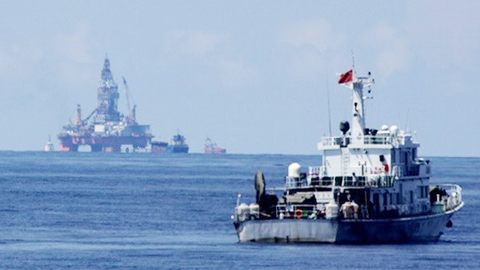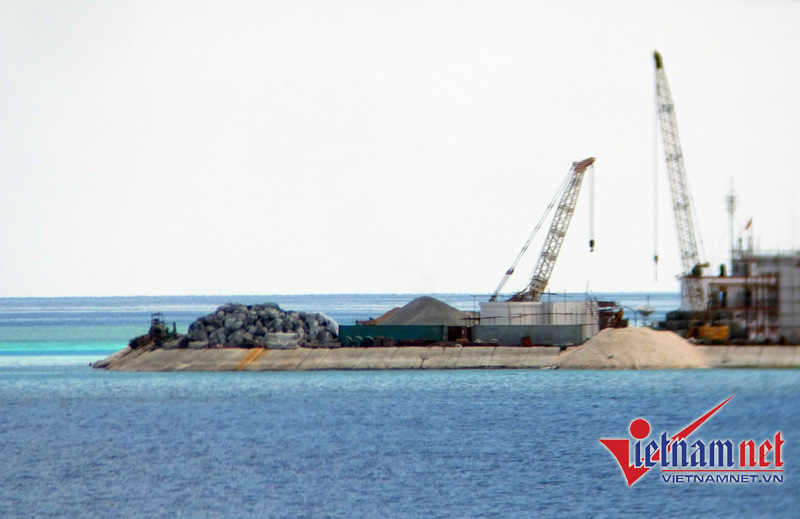
The photo taken from satellites shows Chinese missiles on Phu Lam (Woody) Island - Photo: Fox News
In a study published in 2013, How New and assertive China's New Assertiveness Is [1], Prof. Alastair Johnston (Harvard University) said that "the recent affirmation" of China largely come from the media’s exaggeration. That firm should be placed in the broader and more permanent context of the "peaceful rise" policy that Beijing has announced.
Three years after this studies was published, based on the acts of China in the East Sea and the East China Sea in recent two years, the above arguments should be rewritten: the exaggeration of the media only reflects part of a plan "to become hegemony" of China.
From the unilateral declaration of the air defense identification zone (ADIZ) in the East China Sea, to the triggering an "oil rig crisis" in 2014, and most recently the deployment of missiles on the disputed islands, it is clearly that China is more assertive and reckless than ever in the East Sea dispute.
The gradually increasing aggression of China is not merely a consequence of short-term calculations or the outbreak of nationalism in China. In fact, China has long been pursuing a long-term strategy, with the ultimate goal is to control the entire East Sea.
The expansion strategy of Beijing

In May, China deployed a deepwater rig (HD-981) 120 nautical miles off the coast of Vietnam. Photo: Vietnam Coast Guard
The expansion strategy of China in the East Sea has five main characteristics.
Firstly, the top goal of this strategy is gradually changing the territorial status quo in the East Sea towards China's favor. Instead of trying to swallow the entire East Sea in a move, China began to invade the Paracels Islands in 1974, then gradually occupied the other islands of the Spratly Islands of Vietnam at the end of the 80s. Not long ago, after a clash with the Philippine in 2012, China took control over the Scarborough Shoal.
China hopes that by changing the status quo slowly, they will strengthen the strategic position in the East Sea, as well as create a "fait accompli" to tie the hands of other countries , and at the same time not excessively provoke the remaining parties to avoid a tough, collective response.
Secondly, this strategy is based on "full-spectrum diplomacy”, cleverly using all available diplomatic tools, from the military "stick" to the economic "carrot" and high-ranking negotiations. This is shown most clearly in the HD-981 oil rig crisis.
Beijing sparked the crisis by sending a giant oil rig into the exclusive economic waters (EEZ) of Vietnam, then maintaining the pressure by using a combination of marine vessels and warships which were disguised as civil boats to threaten the fishery administration boats of Vietnam. And finally it conducted “negotiation” diplomatic moves.
Thirdly, China's strategy is mainly based on the provocation on a small scale with high frequency in many different points at the same time. This action helps China stretch the defense capabilities of the enemy and control military escalating capabilities in a moderate extent.
Moreover, it helps prevent the fierce reaction from the group of neighboring countries of China. Because these small countries would think that the price they have to pay when the relations with China deteriorating is greater than the benefits of resistance against the giant neighbor in the East Sea.
Therefore the really big crises such as the Scarborough Shoal or the HD-981 oil rig will rarely happen. Instead, China has been focusing on activities like consolidating artificial islands and gradually militarized disputes.
Fourthly, this strategy emphasizes the "bilateral" nature of territory disputes to prevent the intervention of other countries such as the US and Japan.
China will always be stronger than each smaller neighbor, so of course they will want to negotiate bilaterally with each country to maximize bargaining power. Furthermore, to minimize the "players" in the dispute, China will reduce the risk in their plans. Thus, Beijing will be more confident and tougher in handling disputes.
Finally, China's strategy is based largely on the use of the non-lethal use of force to put pressure on the opponent. Instead of using military strength to directly attack its neighbors, China gradually build a solid position in the East Sea to persuade the small countries to subdue China because if conflicts occur, they will not win.
Therefore, China's main purpose is to "win without fighting". The use of the non-lethal use of force includes actions such as show of military strength to deployment of missile-to-air (SAM) on islands.
China has been successful with this "salami slicing" strategy. So far ASEAN has yet to reach consensus on a collective and assertive response before the expansion of China. Moreover, China has been changing the status quo in the East Sea massively. The evidence is that many works were built on islands in the past few years, including runways for military aircraft of up to 3,000 meters long. The proof is that China continues to erode the sovereignty of other countries in the region, but it has not faced any sanctions from the international community.
Sending a clear message to Beijing

China’s illegal construction activities on Hughes reef in Vietnam’s Spratlys Island. Photo: Huy Phong
The claimant states and those with interests in the East Sea keep making weak response, sending unclear signals, then China has more reason to continue to pursue its expansion strategies. Otherwise, at least Beijing will have to be more cautious and may be have to reconsider its strategy.
In this context, all countries related to the East Sea disputes need a new approach to deal with China’s efforts to change the status quo in the East Sea. Instead of relying only on the “grand measures” as the Code of Conduct (COC), the joint statements of ASEAN, or traditional military deterrence, these countries should regularly carry out small actions, but concrete and substantive to force China to pay for all the actions causing tension and complication in the East Sea dispute. For example, the implementation of smart sanctions aimed at specific subjects who are directly related to the effort to build up the artificial islands in the East Sea.
China will certainly retaliate. Even so, forcing the Chinese to pay the price for each unconstructive action through concrete and practical moves is still very important. Because it sends a clear signal that to Beijing.
As long as the countries involving in the disputes in and having interests in the East Sea only make vague statements or merely symbolic actions, as long as China still see that these countries are afraid of collision. As long as China still reads unclear messages, as long as China still thinks that its current expansion strategy is the best.
It’s time for these countries to force Chinese foreign policy makers to reconsider their calculations.
Ngo Di Lan
* Ngo Di Lan is currently a doctoral student in International Relations - Brandeis University (USA) and an associate researcher at the Center for International Studies (SCIS) of the University of Social Sciences and Humanities, National University of HCM City. The article is part of a presentation delivered at the workshop on the topic "Militarization the South China Sea and the consequences" held at the Harvard University, USA.
-------
[1] How New and assertive China's New Assertiveness Is?